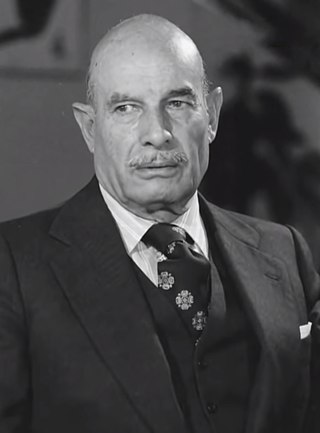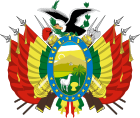
José Luis Tejada Sorzano was a Bolivian economist, lawyer, and politician who served as the 34th president of Bolivia from 1934 to 1936. A member of the Liberal Party, he served as the 23rd vice president from 1931 to 1934 and was minister of finance in 1919.

Carlos Diego de Mesa Gisbert is a Bolivian historian, journalist, and politician who served as the 63rd president of Bolivia from 2003 to 2005. As an independent politician, he had previously served as the 37th vice president of Bolivia from 2002 to 2003 under Gonzalo Sánchez de Lozada and was the international spokesman for Bolivia's lawsuit against Chile in the International Court of Justice from 2014 to 2018. A member of the Revolutionary Left Front, he has served as leader of Civic Community, the largest opposition parliamentary group in Bolivia, since 2018.

General elections were held in Bolivia on 18 December 2005. Evo Morales of the Movement for Socialism (MAS) party was elected President of Bolivia with 54% of the vote, the first time a candidate had received an absolute majority since the flawed 1978 elections. Morales was sworn in on 22 January 2006 for a five-year term. The MAS also won a majority of seats in the Chamber of Deputies and emerged as the largest party in the Senate.

José Enrique Hertzog Garaizábal was a Bolivian physician and politician who served as the 42nd president of Bolivia from 1947 to 1949.

Eliodoro Villazón Montaño was a Bolivian lawyer and politician who served as the 27th president of Bolivia from 1909 to 1913 and as the 15th vice president of Bolivia from 1904 to 1909.

Wálter Guevara Arze was a Bolivian statesman, cabinet minister, writer, and diplomat, who served as the 54th president of Bolivia on an interim basis in 1979.

José Miguel de Velasco Franco was a Bolivian military officer and statesman who served as the fourth president of Bolivia on four occasions: 1828, 1829, 1839–1841, and 1848. Velasco also served as the second vice president from 1829 to 1835 under Andrés de Santa Cruz, though the first two of his terms were as vice president-designate, pending Santa Cruz's arrival to the country.

General elections were held in Bolivia on 1 June 1997. As no candidate for the presidency received over 50% of the vote, the National Congress was required to elect a president on 4 August. Hugo Banzer of Nationalist Democratic Action (ADN) was subsequently elected. Whilst the ADN emerged as the largest party in Congress, it failed to win a majority of seats, and formed a coalition government with the Revolutionary Left Movement, Conscience of Fatherland and the Solidarity Civic Unity.

The Revolutionary Left Front is a political party in Bolivia, founded in 1978.
The Liberal Party was a liberal political party in Bolivia active between 1883 and 1979. It was one of two major parties, alongside the Conservative Party, that dominated the politics of Bolivia from 1884 to 1920. The Liberals constituted the primary opposition to the Conservatives from 1884 to 1899 and ruled continuously from 1899 to 1920 after taking power in the Federal War. Liberal rule ended in 1920 when the party was ousted in a coup d'état. The Liberals remained intermittently influential and electorally competitive until the Bolivian National Revolution of 1952, and it finally lost its legal party status in 1979, during the democratic transition.

General elections were held in Bolivia on 6 June 1993. As no candidate for the presidency received over 50% of the vote, the National Congress was required to elect a president on 4 August. Gonzalo Sánchez de Lozada of the MNR-MRTKL alliance was subsequently elected unopposed.

General elections were held in Bolivia on 9 July 1978. The elections were the first held since 1966, with several military coups taking place during the late 1960s and early 1970s. Although Juan Pereda of the Nationalist Union of the People won the presidential elections according to official statements, more votes were cast than there were registered voters. After examining a number of allegations of fraud and other irregularities, the National Electoral Court decided to annul the results on 19 July. The following day, Pereda was installed as President following a military coup. Pereda himself was overthrown by yet another military coup in November, which saw General David Padilla assume the presidency. Fresh elections were held the following year, with Padilla transferring power to his democratically elected successor, Wálter Guevara.

General elections were held in Bolivia on 1 July 1979. As no candidate in the presidential elections received a majority of the vote, the National Congress was required to elect a President. However, the Congress failed to elect a candidate after three ballots and instead selected Senate leader Wálter Guevara to serve as Interim President for a year on 8 August. Guevara was later overthrown by a military coup led by Alberto Natusch on 31 October. Fresh elections were held in June 1980.

General elections were held in Bolivia on 29 June 1980, the third in three years. As no candidate in the presidential elections received a majority of the vote, the National Congress was required to elect a President on 6 August. With Hernán Siles Zuazo of the Democratic and Popular Union the favourite to win the Congressional ballot, the process was disrupted on 17 July by the military coup led by General Luis García Meza Tejada. However, Meza was pressured to resign on 4 August 1981, resulting in General Celso Torrelio becoming president. In July 1982 he was replaced by General Guido Vildoso, who was named by the high command to return the country to democratic rule. On 17 September 1982, during a general strike that brought the country close to civil war, the military decided to step down, to reconvene the National Congress elected in 1980, and to accept its choice of president. Accordingly, the National Congress revalidated the 1980 election results on 23 September and overwhelmingly elected Hernán Siles Zuazo as president on 5 October. He subsequently assumed the presidency on 10 October 1982.

General elections were held in Bolivia on 14 July 1985. As no candidate for the presidency received over 50% of the vote, the National Congress was required to elect a President on 4 August. Although Hugo Banzer of Nationalist Democratic Action (ADN) received the most public votes, Congress elected Víctor Paz Estenssoro of the Revolutionary Nationalist Movement (MNR).

General elections were held in Bolivia on 6 May 1951. Víctor Paz Estenssoro of the opposition Revolutionary Nationalist Movement (MNR) received the most votes in the presidential election, but as he did not obtain an absolute majority, the National Congress was constitutionally obliged to elect a President on 6 August from the three candidates who received the most public votes. However, on 16 May a military junta assumed responsibility for the Government with Brigadier General Hugo Ballivián as President.

General elections were held in Bolivia on 10 March 1940, electing both a new President of the Republic and a new National Congress. The elections were the first in six years since 1934 and the first not to be annulled in nine years since the general election of 1931.
The Genuine Republican Party was founded in Bolivia in 1921 by José María Escalier and Daniel Domingo Salamanca Urey following a split in the Republican Party.

The Ballivián Cabinet constituted the 34th cabinet of the Republic of Bolivia. It was formed on 9 May 1873 after Adolfo Ballivián was sworn in as the 18th president of Bolivia following the 1873 general election, succeeding the First Frías Cabinet. It was dissolved on 14 February 1874 upon Ballivián's death and was succeeded by the Cabinet of Tomás Frías II.
















